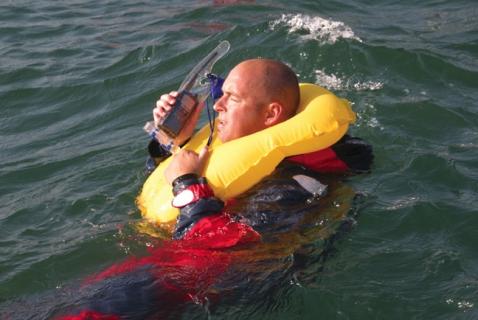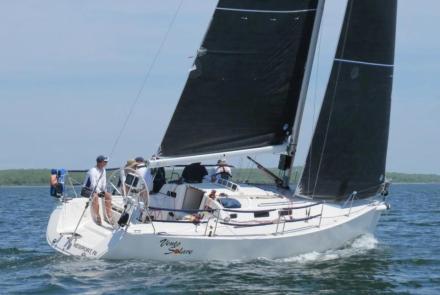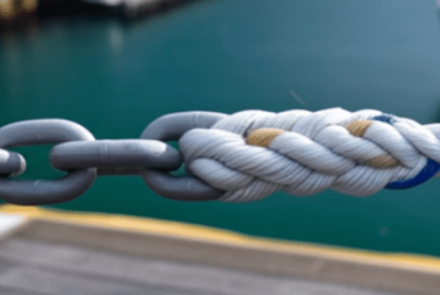So, What’s a Life Jacket Supposed To Do? - - Life Jackets #2
Life Jackets and Harnesses, Part 1
So, what’s a life jacket supposed to do?
“Safety Moments, in support of the Culture of Safety”
By Chuck Hawley, San Francisco Station, 11/1/24/24
When the Safety and Seamanship Committee approached the task of writing a recommendation for harness and lifejacket use, it was suggested that we write a series of articles on the general topic of lifejackets and harnesses as background. This is the first in that series of articles. Our goal is to publish one article every month for about a year. As always, your comments are welcome.
As a reminder, here is the statement that the Safety and Seamanship Committee decided upon:
Stay Onboard; if not, Stay Afloat!
Wearing a life jacket and tether when on deck and underway is part of a vessel’s Culture of Safety. When operating in warm waters, in daylight, and in calm conditions, virtually any approved life jacket will work. When conditions are more challenging, an offshore life jacket plus tether become the “right tools for the job.” It’s vital that you not only have sufficient buoyancy for rough conditions but that you remain attached to the vessel by means of a tether. This greatly reduces the chance of going overboard when rescue may be challenging for your crew.
The use of tethers is recommended under the following conditions:
- Sea conditions: large waves, heavy winds, cold water, confused seas
- Low visibility conditions: nighttime, fog, heavy rain, large seas
- Crew limitations: shorthanded, less experienced, lack of training, age and fitness
- Vessel design: boats with fewer protected spaces, sailing at greater angles of heel, smaller or lighter displacement sailboats with quicker motions
The primary function of a lifejacket for you, as a sailor, is to prevent you from drowning so that if you go overboard your crew members have enough time to return to you and rescue you. In some instances, you may be sailing solo, perhaps on a Laser, so you have to come to your own rescue. Or you may fall out of an inflatable dinghy that hits a wake unexpectedly, and your significant other has to return to pull you aboard. Or you can be sailing in rough conditions, not tethered to the boat, and slip under the lifelines. Regardless of the circumstance, a life jacket gives you incremental buoyancy and, in most cases, prevents you from drowning as you either rescue yourself, or are rescued by the crew of another vessel.
Once you’ve accidentally found yourself in the water, there are two main threats that you have to contend with: swim failure, leading to drowning; and hypothermia, which can eventually kill you by lowering your body temperature but is more likely to cause you to drown. Needless to say, both are to be avoided.
Swim failure is caused by an inability to keep from aspirating water due to breathing when your mouth is immersed. This can be due to a lack of swimming ability, or low freeboard (height of your mouth above the water you’re in), and short period waves. High frequency, short wavelength “choppy” waves tend to make Persons in the Water (PIWs) oscillate from above to below the surface, which leads to frequent mouth immersions. If you can’t time your breathing due to a high rate of respiration from cold water immersion or exhaustion, you begin to aspirate water and start the drowning sequence.
Hypothermia, or its less critical variation, being cold stressed, is caused by immersion in cold water which extracts heat from one’s body and causes impaired movement, shivering, and eventual loss of consciousness. Without sufficient head and neck support, a person will drown quickly after losing the ability to keep their mouth out of the water.
An added challenge when floating in wind-driven waves is the body’s natural tendency to orient you so that you face into the waves, thus funneling water into your face and again forcing you to time your breathing.
There are several life jacket design features that are beneficial to the wearer when immersed in choppy or cold water. These will be covered in a future article, but the ability to provide freeboard (the height of the wearer’s mouth above the calm water surface) improves keeping water out of one’s face. Proper adjustment of your leg or crotch straps maximizes freeboard, while a slack strap allows you to adjust the angle of your body in the water. The inclusion of a storm hood (face shield) also reduces water ingestion. The design of an inflatable chamber can reduce the tendency for it to direct water towards the wearer’s face.
The preceding discussion presumes that we’re dealing with sailors who have fallen overboard while sailing offshore. But what if you find yourself in less threatening conditions: warm inland waters perhaps while dinghy sailing or due to a fall from an inflatable? In those cases, the danger of hypothermia is reduced, and the benefit of having 25 or 35 pounds of buoyancy is also reduced. What is necessary is that the lifejacket allows you to swim short distances, perhaps so you can board a capsized boat, and also for the lifejacket to remain securely on your torso. This should be the case even if you’re ejected from a powerboat at high speeds. In these instances, a float coat might also be an option.
What we think of as “sailing vests” or “dinghy vests” may have the advantage of providing insulation in the torso and axillary areas (armpits) which can help reduce heat loss. What they do not provide is the ability to turn unconscious wearers face-up, a feature which inflatables and high buoyancy foam lifejackets provide.
In future articles, we’ll discuss the confusing categorization of lifejackets, attempt to thread the needle on the advantages and disadvantages of inherently-buoyant and inflatable lifejackets, and the conditions under which wearing a harness and tether are a good idea.
The Cruising Club of America is a collection of accomplished ocean sailors having extensive boat handling, seamanship, and command experience honed over many years. “Safety Moments” are written by the Club’s Safety Officers from CCA Stations across North America and Bermuda, as well as CCA members at large. They are published by the CCA Safety and Seamanship Committee and are intended to advance seamanship and safety by highlighting new technologies, suggestions for safe operation and reports of maritime disasters around the world.





